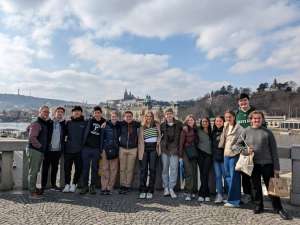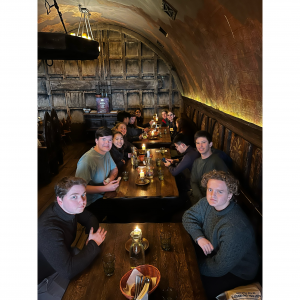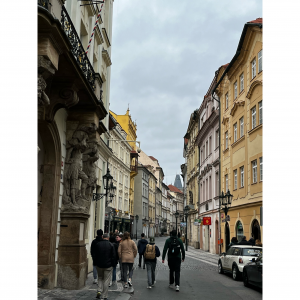David ’25, Cormac ’26, Sungmin ’26, Joe ‘ 25, and Svetlana ’25, recount the groups visit to the Jewish Quarter, one of the oldest Jewish ghettos in Europe.
Pinkas Synagogue and Cemetery
On our last day in Prague, our group visited the Jewish Quarter. We woke up early to finish packing and organizing our bags for the bus ride to Kraków in the afternoon. When we had finished breakfast, we took a tram to the Jewish Quarter, and even though the trip was short, I had fun experiencing the public transportation in Prague. The Jewish Quarter, also known as the Jewish ghetto, was the area of Prague in which Jews historically lived. Just as in many other Jewish ghettos, monarchical rulers of Prague periodically forced Jews to live in this crowded area long before the rise of the Nazi party. Throughout the quarter, we visited several synagogues and other culturally significant sites.
The first area we stepped into was, for me, the most stunning. The Pinkas synagogue, built in the 16th century, now holds the handwritten names of nearly 80,000 Czech Jews who were murdered during the Holocaust. I’ve been most struck by lists such as this—the sheer enormity of the walls upon walls of names at the Pinkas synagogue made the systematic murder feel both more massive and more personal. After leaving the names behind, we walked through the Old Jewish Cemetery, which was used from the 15th century up until the 1780’s. Because Jews were often only allowed to be buried here, bodies piled up over the centuries, and the cemetery today contains gravestones practically piled atop each other and partially buried. In the cemetery lies many famous Czech Jews, including Aaron Meshulam Horowitz and Mordechai Maisel, who built the Pinkas and Maisel synagogues, and Rabbi Loew. According to legend, in the 16th century, Rabbi Loew constructed a golem out of clay from the riverbank and brought it to life in order to defend the ghetto from pogroms.
As we walked through these areas, I was constantly reminded of the tumultuous history of Jews throughout Europe. Throughout European history, far before the rise of National Socialism, Jews lived under constantly changing oppressive rules and chaotic persecution.
-David ’25
Old-New Synagogue
After leaving the cemetery, we made our way over to the oldest practicing synagogue in Europe, the so-called “Old-New Synagogue”. It was given this confusing name because when it was originally built in 1270, it was meant to replace the Old Synagogue, and thus was given the name of New Synagogue. Once the Old Synagogue was demolished and the Spanish Synagogue was put up in its place, however, the former New Synagogue became known as the Old-New Synagogue. Being an orthodox synagogue, the Old-New Synagogue has two different sections, one for men to pray and participate in the service and a separate chamber for women, who had to watch the service through various windows. There are a few different legends revolving around this synagogue, most notably that of the Golem of Prague. According to this legend, the 16th century rabbi Judah Loew ben Bezalel created a golem out of inanimate clay in order to protect the Jewish community of Prague. The remains of this golem are said to be stored in the attic of the synagogue.
Another popular legend is that when the synagogue was being built, angels came down and delivered stones from the Temple in Jerusalem, but only on the condition that they be returned to the original site once needed. Overall, this synagogue was quite small, but learning about its rich history within the Jewish community of Prague from our tour guide made it much more interesting.
-Cormac ’26
Following the visits to the cemetery and the synagogues, it was time for lunch. We walked around the beautiful city and eventually arrived at our destination, which was a restaurant that was like no other that I had experienced. Walking in through the front doors, I was taken back to the medieval age. The restaurant was fully decorated with wood and was dimly lit by candles that were placed throughout the restaurant on various tables and on chandeliers. Sitting down at our wooden table and looking around, I realized how special this restaurant was. I was hoping that the food would match my excitement, and it did not disappoint. We started with a Borscht soup appetizer, which now is my favorite soup of the trip. Then came the cheese gnocchi, which reminded me of a warm, comforting mac and cheese. Finally, for dessert, we had something that mimicked a pancake but was done at a quality much higher than anything I had experienced before. Overall, the ambiance of the restaurant matched the level of service and food perfectly and is definitely one of my favorite meals thus far.
-Sungmin ’26
In Prague a group of students including myself broke off for a quick moment with Mr. Tyree to take a look at the church of our lady before Tyn in the city square. It portrayed the gothic architecture present in a lot of Prague’s old and stunning buildings and had wonderful frescos. It was a good addition to our pallet of churches throughout Europe and a nice piece of information that juxtaposed our tours of synagogues.
– Joe ‘ 25
Our final destination before lunch in Prague was the Spanish Synagogue. It was built in the middle of the 19th century in a Moorish style – inspired by Spanish architecture. When we walked into the arched entryway of the synagogue we were immediately met with golden brimmed edges, a plethora of gold detailing, and a dark ambience. Clearly, I was mesmerized by the abundance of gold. The synagogue was not in use anymore, and instead was used as a museum as the back benches were embedded with screens that explained important figures in Judaism. We spent our remaining fifteen minutes observing this intricate synagogue before leaving for lunch.
Following a seemingly never-ending (seven hour) bus ride to Poland, we attended our reservation for dinner. The restaurant had a long dark room, which made it difficult to stay awake after my refreshing nap on the bus. The traditional Polish restaurant served a dish that was comparable to a piece of grilled cheese for appetizers. They were little pockets equipped with cheese and jam. For the main course, we had ribs, which did not disappoint. And finally, for dessert we had a classic apple crisp.
-Svetlana ’25



